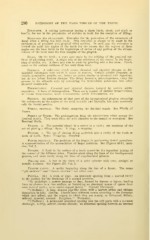Page 442 - My FlipBook
P. 442
290 PATHOLOGY OF THE HAKD TISSUES OF THE TEETH.
Excavator. A cutting instrument having a sharp blade, shank, and shaft or
handle, for use in the preparation of cavities in teeth for the reception of fillings.
Extension for prevention. Extension for the prevention of the recurrence of
decay after a filling has been made. This extension is always to be made in the
preparation of proximal and gingival third cavities. In each case the extension is
toward the axial line angles of the tooth for the reason that the regions of these
angles are the least liable to the beginnings of caries of any portion of the circum-
ference of the tooth near the free margins of the gingivae.
Facet. On the teeth ; a worn spot made by the rubbing of the proximal sur-
faces of adjoining teeth. A slight loss of the substance of the enamel in the begin-
ning of erosion, etc. A facet may also be made by grinding with a fine stone. Facets
occur on the occlusal surfaces of the teeth from wear.
Ferment. A substance which causes chemical and physical changes in fer-
mentable substances with which it comes in contact. Certain soluble ferments, as
pepsin, pancreatin. ptyalin, etc., induce an action similar or identical with digestion;
but do not induce further changes. The living ferments, microorganisms, carry the
process to its ultimate ends by converting the fermentable substances into other
chemical compounds.
Fermentation. Chemical and physical changes induced by certain micro-
organisms. A form of decomposition. There are a number of distinct fermentations,
as vinous fermentation, lactic fermentation, acetic fermentation, etc.
Festoon. An enlargement of that part of the interproximal gingivae occupying
the embrasures at the angles of the teeth buccally aad linguallv. but more commonly
only the buccal portion.
Fibrils, dentinal. The fibrils occupying the dentinal canals. See Fibrils of
Tomes.
Fibrils of Tomes. The prolongations from the odontoblasts which occupy the
dentinal canals. They reach from the pulp chamber to the enamel or eementum. See
Dentinal fibrils.
Filling, n. The material placed in a cavity in a tooth; the resultant of the
act of placing a filling.' Syns. : A plug; a stopping.
Filling, v. The act of placing filling materials into a cavity of the tooth or
roots of teeth. Syns: Plugging; stopping.
Finger positions. The positions of the fingers in performing dental operations.
A systematization of the nomenclature of finger positions. See Figures 46-61, inclu-
sive, Vol. 2.
Fissure. A fault in the surface of a tooth caused by the imperfect joining of
the enamel of the different lobes. Fissures occur along the lines of the developmental
grooves, and more rarely along the lines of supplemental grooves.
Fissure bur. A bur in the form of a solid cylinder with even, straight or
parallel surfaces. See Figure 137, Vol. 2.
Fissure cavity. A cavity beginning along the line of a fissure. The terms
"pit cavities" and "fissure cavities" are often used.
Fistula. [L] A reed, or pipe. An abnormal opening from a normal cavity
to the surface for the discharge of a normal secretion.
"In pathology, a narrow passage or duct, formed by disease or injury, leading
from an abscess to a free surface, or furnishing an abnormal means of egress from
some normal cavity, as in vesico-vaginal fistula." Century Dictionary.
" (Medical.) A long, sinuous pipe-like ulcer, with a narrow orifice and without
disposition to heal. Hoblyn. Fistulae have different names according to the discharge
which they afford, and the organs in which they are seated, as lachrymal, biliary,
salivary, synovial, urinary. Dunglison." Worcester.
" (Medical.) A permanent, abnormal opening into the soft parts with a constant
discharge; a deep, narrow, chronic abscess; an abnormal opening between an internal


